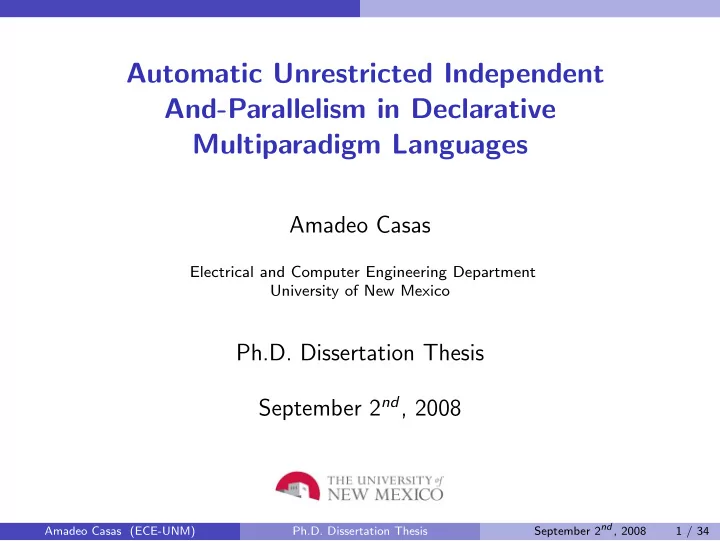

Automatic Unrestricted Independent And-Parallelism in Declarative Multiparadigm Languages Amadeo Casas Electrical and Computer Engineering Department University of New Mexico Ph.D. Dissertation Thesis September 2 nd , 2008 September 2 nd , 2008 Amadeo Casas (ECE-UNM) Ph.D. Dissertation Thesis 1 / 34
Outline 1 Introduction and Motivation 2 Background 3 Functions and Lazy Evaluation Support for LP Kernels 4 Annotation Algorithms for Unrestricted IAP 5 High-Level Implementation of Unrestricted IAP 6 Concluding Remarks and Future Work 7 Publications September 2 nd , 2008 Amadeo Casas (ECE-UNM) Ph.D. Dissertation Thesis 2 / 34
Introduction and Motivation 1 Introduction and Motivation 2 Background 3 Functions and Lazy Evaluation Support for LP Kernels 4 Annotation Algorithms for Unrestricted IAP 5 High-Level Implementation of Unrestricted IAP 6 Concluding Remarks and Future Work 7 Publications September 2 nd , 2008 Amadeo Casas (ECE-UNM) Ph.D. Dissertation Thesis 3 / 34
Introduction and Motivation Introduction Parallelism (finally!) becoming mainstream thanks to multicore architectures — even on laptops! Parallelizing programs is a hard challenge. ◮ Necessity to exploit parallel execution capabilities as easily as possible. Renewed research interest in development of tools to write parallel programs: ◮ Design of languages that better support exploitation of parallelism. ◮ Improved libraries for parallel programming. ◮ Progress in support tools: parallelizing compilers . September 2 nd , 2008 Amadeo Casas (ECE-UNM) Ph.D. Dissertation Thesis 4 / 34
Introduction and Motivation Why Logic Programming? Significant progress made in parallelizing compilers for regular computations. But further challenges: ◮ Parallelization across procedure calls. ◮ Irregular computations. ◮ Complex data structures (as in C/C++). ⋆ Much current work in independence analyses: pointer aliasing analysis . ◮ Speculation. Declarative languages are a very interesting framework for parallelization: ◮ All the challenges above appear in the parallelization of LP! ◮ But: ⋆ Program much closer to problem description. ⋆ Notion of control provides more flexibility. ⋆ Cleaner semantics (e.g., pointers exist, but are declarative). September 2 nd , 2008 Amadeo Casas (ECE-UNM) Ph.D. Dissertation Thesis 5 / 34
Introduction and Motivation Declarative / multiparadigm languages Multiparadigm languages — building on the best features of each paradigm: ◮ Logic programming : expressive power beyond that of functional programming. ⋆ Nondeterminism. ⋆ Partially instantiated data structures. ◮ Functional programming : syntactic convenience. ⋆ Designated output argument: provides more compact code. ⋆ Lazy evaluation: ability to deal with infinite data structures. → We support both logic and functional programming. − Industry interest: ◮ Intel sponsorship of DPMC and DAMP (colocated with POPL) workshops. Cross-paradigm synergy : better parallelizing compilers can be developed by mixing results from different paradigms. September 2 nd , 2008 Amadeo Casas (ECE-UNM) Ph.D. Dissertation Thesis 6 / 34
Background 1 Introduction and Motivation 2 Background 3 Functions and Lazy Evaluation Support for LP Kernels 4 Annotation Algorithms for Unrestricted IAP 5 High-Level Implementation of Unrestricted IAP 6 Concluding Remarks and Future Work 7 Publications September 2 nd , 2008 Amadeo Casas (ECE-UNM) Ph.D. Dissertation Thesis 7 / 34
Background Types of parallelism in LP Two main types: ◮ Or-Parallelism : explores in parallel alternative computation branches . ◮ And-Parallelism : executes procedure calls in parallel. ⋆ Traditional parallelism: parbegin-parend, loop parallelization, divide-and-conquer, etc. ⋆ Often marked with &/2 operator: fork-join nested parallelism. September 2 nd , 2008 Amadeo Casas (ECE-UNM) Ph.D. Dissertation Thesis 8 / 34
Background Types of parallelism in LP Two main types: ◮ Or-Parallelism : explores in parallel alternative computation branches . ◮ And-Parallelism : executes procedure calls in parallel. ⋆ Traditional parallelism: parbegin-parend, loop parallelization, divide-and-conquer, etc. ⋆ Often marked with &/2 operator: fork-join nested parallelism. Example (QuickSort: sequential and parallel versions) qsort([], []). qsort([], []). qsort([X|L], R) :- qsort([X|L], R) :- partition(L, X, SM, GT), partition(L, X, SM, GT), qsort(GT, SrtGT) & qsort(GT, SrtGT), qsort(SM, SrtSM), qsort(SM, SrtSM), append(SrtSM, [X|SrtGT], R). append(SrtSM, [X|SrtGT], R). We will focus on and-parallelism. ◮ Need to detect independent tasks. September 2 nd , 2008 Amadeo Casas (ECE-UNM) Ph.D. Dissertation Thesis 8 / 34
Background Parallel execution and independence Correctness: same results as sequential execution. Efficiency: execution time ≤ than seq. program (no slowdown), assuming parallel execution has no overhead. s 1 Y := W+2; (+ (+ W 2) Y = W+2, s 2 X := Y+Z; Z) X = Y+Z, Imperative Functional CLP September 2 nd , 2008 Amadeo Casas (ECE-UNM) Ph.D. Dissertation Thesis 9 / 34
Background Parallel execution and independence Correctness: same results as sequential execution. Efficiency: execution time ≤ than seq. program (no slowdown), assuming parallel execution has no overhead. s 1 Y := W+2; (+ (+ W 2) Y = W+2, s 2 X := Y+Z; Z) X = Y+Z, Imperative Functional CLP main :- p(X) :- X = [1,2,3]. s 1 p(X), s 2 q(X), q(X) :- X = [], large computation . write(X). q(X) :- X = [1,2,3]. Fundamental issue: p affects q (prunes its choices). ◮ q ahead of p is speculative . Independence: correctness + efficiency . September 2 nd , 2008 Amadeo Casas (ECE-UNM) Ph.D. Dissertation Thesis 9 / 34
Recommend
More recommend